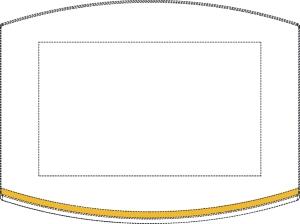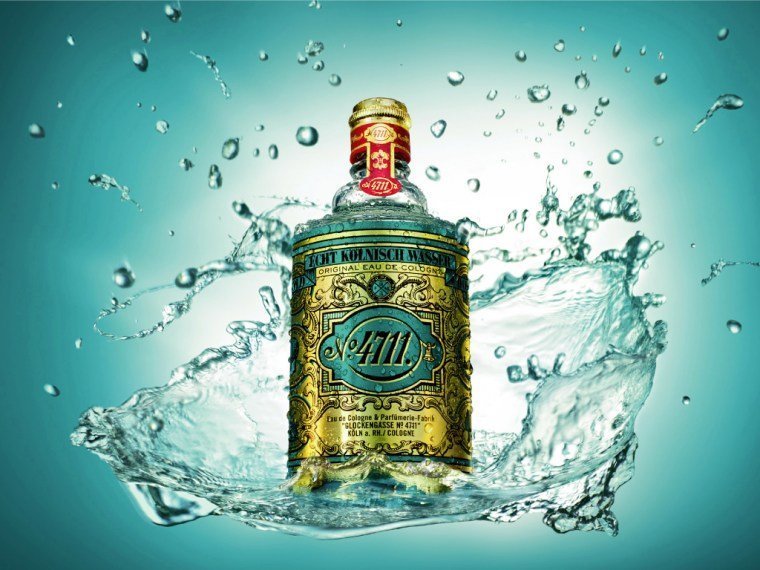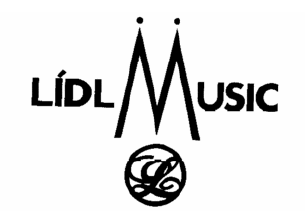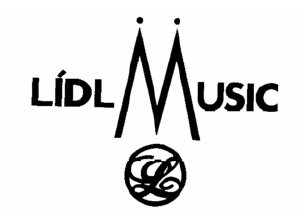Gerecht EU week 9
Gemeenschapsmerk. We beperken ons tot een wekelijks overzicht van de (voortgezette oppositie)beslissingen van het Gerecht EU. Ditmaal over:
A) Beroep "gele boog onder aan scherm" afgewezen [Sartorius v. BHIM]
B) Beroep 4711 AQUA MIRABILIS afgewezen [tegen AQUA ADMIRABILIS]
C) Beroep TEEN VOGUE afgewezen [tegen VOGUE]
D) Beroep LIDL EXPRESS afgewezen [tegen LÍDL MUSIC]
E) Beroep "LIDL" afgewezen [tegen LÍDL MUSIC]
F) Beroep "VOGUE" gedeeltelijk toegewezen [tegen VOGUE & "VOGUE moda en lluvia"]
G) Beroep TEEN VOGUE afgewezen [tegen VOGUE]
H) Beroep QTA S. JOSÉ DE PERAMANCA afgewezen [tegen „VINHO PÊRAMANCA TINTO”, „VINHO PÊRAMANCA BRANCO” & „PÊRAMANCA”]
I) Beroep GE afgewezen [tegen GE & GE]
Gerecht EU 26 februari 2014, zaak T-331/12 (gele boog onder aan scherm) - dossier Gemeenschapsmerk – Vernietiging van beslissing houdende verwerping van beroep tegen de weigering van de onderzoeker om een merk in de vorm van een gele boog aan de onderkant van een elektronisch scherm in te schrijven voor waren van de klassen 7, 9, 10 en 11. Het beroep is afgewezen.
Gemeenschapsmerk – Vernietiging van beslissing houdende verwerping van beroep tegen de weigering van de onderzoeker om een merk in de vorm van een gele boog aan de onderkant van een elektronisch scherm in te schrijven voor waren van de klassen 7, 9, 10 en 11. Het beroep is afgewezen.
39 Het aangevraagde teken vormt een eenvoudig dessin. Ondanks de felle kleur ervan bevat het geen enkel opvallend element dat de aandacht van het relevante publiek kan trekken, zelfs al moest dit worden geacht zeer aandachtig te zijn. Zoals uit punt 38 supra voortvloeit en anders dan verzoekster stelt, is het in de betrokken sector niet ongebruikelijk om een dergelijke „visuele aanwijzing” in kleur rond het scherm van het apparaat aan te brengen. Bovendien voert verzoekster niet aan dat het aangevraagde merk betrekking had op een specifieke geeltint. Bijgevolg moet worden geoordeeld dat het aangevraagde merk geen unieke, originele of ongebruikelijke kenmerken heeft.
41 Zo is het loutere feit dat andere merken, ook al zijn die even eenvoudig, werden geacht de herkomst van de aangeduide waren te kunnen aanduiden en dus niet elk onderscheidend vermogen te missen, niet afdoende om vast te stellen dat het aangevraagde merk ook het minimale onderscheidend vermogen bezit dat is vereist om te kunnen worden ingeschreven (zie in die zin arrest Weergave van halve glimlach van smiley, punt 19 supra, punt 34). Een merk kan echter onderscheidend vermogen verkrijgen doordat het gedurende een tijd wordt gebruikt, maar verzoekster voert in casu geen enkel argument op basis van artikel 7, lid 1, van verordening nr. 207/2009 aan.
Gerecht EU 27 februari 2014, zaak T-24/13 (4711 Aqua Mirabilis) - dossier
 Gemeenschapsmerk – Beroep door de aanvrager van het woordmerk 4711 AQUA MIRABILIS voor waren van klasse 3 ingesteld en strekkende tot vernietiging van beslissing houdende verwerping van het beroep tegen de gedeeltelijke weigering van de oppositieafdeling om dat merk in te schrijven in het kader van de oppositie ingesteld door de houder van het gemeenschapswoordmerk AQUA ADMIRABILIS voor waren van klasse 3. Het beroep is afgewezen.
Gemeenschapsmerk – Beroep door de aanvrager van het woordmerk 4711 AQUA MIRABILIS voor waren van klasse 3 ingesteld en strekkende tot vernietiging van beslissing houdende verwerping van het beroep tegen de gedeeltelijke weigering van de oppositieafdeling om dat merk in te schrijven in het kader van de oppositie ingesteld door de houder van het gemeenschapswoordmerk AQUA ADMIRABILIS voor waren van klasse 3. Het beroep is afgewezen.
39 Selbst wenn das Vorbringen der Klägerin zur geringen Kennzeichnungskraft der älteren Marke zu berücksichtigen wäre, erweisen sich die von der Beschwerdekammer zu Recht festgestellte Identität oder Ähnlichkeit der in Rede stehenden Waren (siehe oben, Rn. 17) sowie die Ähnlichkeit zwischen den einander gegenüberstehenden Zeichen (siehe oben, Rn. 33) demnach bei kumulativer Betrachtung im vorliegenden Fall jedenfalls als ausreichend, um das Vorliegen einer Verwechslungsgefahr bejahen zu können (vgl. insoweit Urteile des Gerichts vom 16. Mai 2012, Wohlfahrt/HABM – Ferrero [Kindertraum], T‑580/10, noch nicht in der amtlichen Sammlung veröffentlicht, Rn. 54, und vom 25. Oktober 2012, riha/HABM – Lidl Stiftung [VITAL&FIT], T‑552/10, noch nicht in der amtlichen Sammlung veröffentlicht, Rn. 65). Das Vorbringen der Klägerin zur geringen Kennzeichnungskraft der älteren Marke kann deshalb die zutreffende Beurteilung der Verwechslungsgefahr durch die Beschwerdekammer nicht in Frage stellen und ist damit als ins Leere gehend zurückzuweisen.
Gerecht EU 27 februari 2014, zaak T-37/12 (TEEN VOGUE) - dossier
 Gemeenschapsmerk – Beroep ingesteld door de aanvrager van het woordmerk TEEN VOGUE voor onder meer waren van klasse 18, en strekkende tot vernietiging van beslissing houdende verwerping van het beroep tegen de beslissing van de oppositieafdeling waarbij de inschrijving van dit merk gedeeltelijk is geweigerd in het kader van de oppositie ingesteld door de houder van de nationale woord- en beeldmerken en het gemeenschapswoordmerk met het woordelement VOGUE voor waren van klasse 18. Het beroep is afgewezen.
Gemeenschapsmerk – Beroep ingesteld door de aanvrager van het woordmerk TEEN VOGUE voor onder meer waren van klasse 18, en strekkende tot vernietiging van beslissing houdende verwerping van het beroep tegen de beslissing van de oppositieafdeling waarbij de inschrijving van dit merk gedeeltelijk is geweigerd in het kader van de oppositie ingesteld door de houder van de nationale woord- en beeldmerken en het gemeenschapswoordmerk met het woordelement VOGUE voor waren van klasse 18. Het beroep is afgewezen.
77 The global assessment implies some interdependence between the factors taken into account, and in particular between the similarity of the trade marks and the similarity of the goods or services concerned. Accordingly, a lesser degree of similarity between those goods or services may be offset by a greater degree of similarity between the marks, and vice versa (Case C‑39/97 Canon [1998] ECR I‑5507, paragraph 17, and Joined Cases T‑81/03, T‑82/03 and T‑103/03 Mast-Jägermeister v OHIM – Licorera Zacapaneca (VENADO with frame and others) [2006] ECR II‑5409, paragraph 74).
78 In light of the visual and phonetic similarities of the signs at issue and having regard to the fact that the goods designated by the earlier Spanish word mark VOGUE, on the one hand, and the mark applied for, on the other, are identical, the Board of Appeal did not make an error of assessment in finding that there was a likelihood of confusion between those marks. The applicant’s argument that the absence of the element ‘teen’ in the earlier Spanish word mark VOGUE suffices to avoid all likelihood of confusion must be rejected, since it was held at paragraphs 67 to 71 above that the presence of that element in the mark applied for does not introduce such a dissimilarity between the signs at issue as would lead to erasing their similarities. Thus, the Board of Appeal was correct to confirm the Opposition Division’s decision refusing registration of the mark applied for as regards ‘umbrellas, parasols, parts and fittings for all the aforesaid goods’ in Class 18.
Gerecht EU 27 februari 2014, zaak T-225/12 (LIDL express) - dossier
 Gemeenschapsmerk - Door aanvrager van beeldmerk met de woorden LIDL EXPRESS voor waren van klasse 15 ingesteld beroep tot vernietiging van beslissing tot verwerping van het beroep tegen de beslissing van de oppositieafdeling waarbij de inschrijving van dit merk is geweigerd in het kader van de oppositie van de houder van het nationale beeldmerk en gemeenschapswoordmerk met de woorden „LÍDL MUSIC” voor waren van klasse 15. Het beroep is afgewezen.
Gemeenschapsmerk - Door aanvrager van beeldmerk met de woorden LIDL EXPRESS voor waren van klasse 15 ingesteld beroep tot vernietiging van beslissing tot verwerping van het beroep tegen de beslissing van de oppositieafdeling waarbij de inschrijving van dit merk is geweigerd in het kader van de oppositie van de houder van het nationale beeldmerk en gemeenschapswoordmerk met de woorden „LÍDL MUSIC” voor waren van klasse 15. Het beroep is afgewezen.
83 The global assessment of the likelihood of confusion must, as regards the visual, aural or conceptual similarity of the marks in question, be based on the overall impression created by them, bearing in mind, in particular, their distinctive and dominant components (see OHIM v Shaker, paragraphs 34 and 35, and Case C‑498/07 P Aceites del Sur-Coosur v Koipe [2009] ECR I‑7371, paragraphs 59 and 60 and the case-law cited). Furthermore, it implies some interdependence of the factors taken into account, so that a low degree of similarity between the goods or services covered may be offset by a high degree of similarity between the marks, and vice versa (judgment of 17 April 2008 in Case C‑108/07 P Ferrero Deutschland v OHIM, not published in the ECR, paragraphs 44 and 45).
84 Therefore, since the goods covered by the marks at issue are identical — which the applicant does not dispute — and those marks are similar, the Board of Appeal was entitled to conclude that there was a likelihood of confusion within the meaning Article 8(1)(b) of Regulation No 207/2009.
Gerecht EU 27 februari 2014, zaak T-226/12 (LIDL) - dossier

 Gemeenschapsmerk – Door aanvrager van beeldmerk met het woord „LIDL” voor waren van klasse 15 ingesteld beroep tot vernietiging van beslissing tot verwerping van het beroep tegen de beslissing van de oppositieafdeling waarbij de inschrijving van dit merk is geweigerd in het kader van de oppositie van de houder van het nationale beeldmerk en gemeenschapswoordmerk met de woorden „LÍDL MUSIC” voor waren van klasse 15. Het beroep is afgewezen.
Gemeenschapsmerk – Door aanvrager van beeldmerk met het woord „LIDL” voor waren van klasse 15 ingesteld beroep tot vernietiging van beslissing tot verwerping van het beroep tegen de beslissing van de oppositieafdeling waarbij de inschrijving van dit merk is geweigerd in het kader van de oppositie van de houder van het nationale beeldmerk en gemeenschapswoordmerk met de woorden „LÍDL MUSIC” voor waren van klasse 15. Het beroep is afgewezen.
83 The global assessment of the likelihood of confusion must, as regards the visual, aural or conceptual similarity of the marks in question, be based on the overall impression created by them, bearing in mind, in particular, their distinctive and dominant components (see OHIM v Shaker, paragraphs 34 and 35, and Case C‑498/07 P Aceites del Sur-Coosur v Koipe [2009] ECR I‑7371, paragraphs 59 and 60 and the case-law cited). Furthermore, it implies some interdependence of the factors taken into account, so that a low degree of similarity between the goods or services covered may be offset by a high degree of similarity between the marks, and vice versa (judgment of 17 April 2008 in Case C‑108/07 P Ferrero Deutschland v OHIM, not published in the ECR, paragraphs 44 and 45).
84 Therefore, since the goods covered by the marks at issue are identical — which the applicant does not dispute — and those marks are similar, the Board of Appeal was entitled to conclude that there was a likelihood of confusion within the meaning Article 8(1)(b) of Regulation No 207/2009.
Gerecht EU 27 februari 2014, zaak T-229/12 (VOGUE) - dossier

 Gemeenschapsmerk – Door aanvrager van beeldmerk met het woord "VOGUE" voor waren en diensten van de klassen 3, 9, 14, 16, 18, 21, 24, 26, 28, 35, 38, 39, 40, 41, 42, 43, 44 en 45, ingesteld beroep tot vernietiging van beslissing tot verwerping van het beroep tegen de beslissing van de oppositieafdeling waarbij de inschrijving van dit merk gedeeltelijk is geweigerd in het kader van de oppositie van de houder van de nationale en communautaire woordmerken VOGUE en het nationale beeldmerk met de woorden "VOGUE moda en lluvia", voor waren van klasse 18. Het beroep is gedeeltelijk toegewezen.
Gemeenschapsmerk – Door aanvrager van beeldmerk met het woord "VOGUE" voor waren en diensten van de klassen 3, 9, 14, 16, 18, 21, 24, 26, 28, 35, 38, 39, 40, 41, 42, 43, 44 en 45, ingesteld beroep tot vernietiging van beslissing tot verwerping van het beroep tegen de beslissing van de oppositieafdeling waarbij de inschrijving van dit merk gedeeltelijk is geweigerd in het kader van de oppositie van de houder van de nationale en communautaire woordmerken VOGUE en het nationale beeldmerk met de woorden "VOGUE moda en lluvia", voor waren van klasse 18. Het beroep is gedeeltelijk toegewezen.
53 In the present case, it is necessary to find that the global assessment of the likelihood of confusion by the Board of Appeal did not infringe Article 8(1)(b) of Regulation No 207/2009 as regards, first, umbrellas and, second, parasols. In the first instance, the goods at issue are identical and the signs at issue are visually highly similar, phonetically identical and conceptually identical or neutral, as the case may be. Therefore, the Board of Appeal was right to find, concerning those types of goods, a likelihood of confusion between the earlier Community word mark VOGUE and the mark applied for. In the second instance, the low degree of similarity between parasols and umbrellas is, in the present case, offset by the strong visual similarity and the phonetic identity, as well as the conceptual identity for French or English-speaking consumers, of the signs at issue. Consequently, it is necessary to hold that the Board of Appeal’s inaccuracy in comparing parasols and umbrellas does not affect its conclusion regarding the likelihood of confusion, in that respect, between the earlier Community word mark VOGUE and the mark applied for.
54 On the other hand, the Board of Appeal was wrong to consider that there was a likelihood of confusion between the mark applied for and the earlier Community word mark VOGUE as regards accessories. For the purposes of applying Article 8(1)(b) of Regulation No 207/2009, a likelihood of confusion presupposes both that the marks at issue are identical or similar and that the goods or services which they cover are identical or similar, those conditions are cumulative (see easyHotel, paragraph 42 and the case-law cited). Consequently, the similarity or identical nature of the signs at issue cannot offset the lack of any assessment of the similarity of the goods at issue, namely, accessories and umbrellas, since the applicant had not sufficiently defined what it meant by ‘accessories’, by example by seeking to restrict its application for a Community trade mark.
55 It should be borne in mind that the General Court reviews the legality of the decisions of OHIM bodies. If it holds that such a decision, called into question in an action brought before it, is vitiated by illegality, it must annul it. It may not dismiss the action while substituting its own reasoning for that of the competent OHIM body which is the author of the contested act (Case T-402/07 Kaul v OHIM – Bayer (ARCOL) [2009] ECR II-737, paragraph 49, and Case T‑70/08 Axis v OHIM – Etra Investigación y Desarrollo (ETRAX) [2010] ECR II‑4645, paragraph 29). It is therefore for OHIM to draw the appropriate conclusions from this judgment in the light of all the legal and factual considerations which it will have in its possession, in particular the findings at paragraphs 34, 35, 38 and 40 of this judgment and the wording of the judgment delivered today in Case T-37/12, also between the applicant and OHIM.
56 Therefore, the first part of the applicant’s single plea in law must be upheld in part and the contested decision must be annulled in so far as the Board of Appeal confirmed the Opposition Division’s decision upholding the opposition for ‘accessories’. The upholding in part of the first part of the single plea in law renders irrelevant, first, the second part of that plea in law and, second, the applicant’s second claim, to which that second part was related exclusively, seeking the opposition to be upheld solely in relation to umbrellas, parasols and accessories for umbrellas and parasols.
Gerecht EU 27 februari 2014, zaak T-509/12 (TEEN VOGUE) - dossier
 Gemeenschapsmerk – Beroep ingesteld door de aanvrager van het woordmerk TEEN VOGUE, voor waren van onder andere klasse 25, strekkende tot vernietiging van beslissing waarbij is verworpen het beroep tegen de beslissing van de oppositieafdeling houdende weigering van inschrijving van dat merk in het kader van de oppositie van de houder van het nationale woordmerk en het nationale beeldmerk die het woordelement „VOGUE” bevatten, voor waren van klasse 25. Het beroep is afgewezen.
Gemeenschapsmerk – Beroep ingesteld door de aanvrager van het woordmerk TEEN VOGUE, voor waren van onder andere klasse 25, strekkende tot vernietiging van beslissing waarbij is verworpen het beroep tegen de beslissing van de oppositieafdeling houdende weigering van inschrijving van dat merk in het kader van de oppositie van de houder van het nationale woordmerk en het nationale beeldmerk die het woordelement „VOGUE” bevatten, voor waren van klasse 25. Het beroep is afgewezen.
48 De globale beoordeling van het verwarringsgevaar veronderstelt een zekere onderlinge samenhang tussen de in aanmerking te nemen factoren, met name tussen de overeenstemming van de merken en de soortgelijkheid van de waren of diensten waarop zij betrekking hebben. Zo kan een geringe mate van soortgelijkheid van de betrokken waren of diensten worden gecompenseerd door een hoge mate van overeenstemming van de merken, en omgekeerd [arrest Hof van 29 september 1998, Canon, C‑39/97, Jurispr. blz. I‑5507, punt 17, en arrest Gerecht van 14 december 2006, Mast-Jägermeister/BHIM – Licorera Zacapaneca (VENADO met kader e.a.), T‑81/03, T‑82/03 en T‑103/03, Jurispr. blz. II‑5409, punt 74].
49 Rekening houdend met de visuele en fonetische overeenstemming van de conflicterende tekens en gelet op het feit dat de waren waarop het oudere Zweedse woordmerk VOGUE enerzijds, en het aangevraagde merk anderzijds, betrekking hebben, gedeeltelijk dezelfde en gedeeltelijk soortgelijk zijn, heeft de kamer van beroep geen blijk gegeven van een onjuiste opvatting door te oordelen dat sprake was van gevaar voor verwarring tussen deze merken en door dus de beslissing van de oppositieafdeling te bevestigen waarbij de inschrijving van het aangevraagde merk werd geweigerd voor „kledingstukken; schoeisel; hoofddeksels; onderdelen en accessoires voor alle voornoemde goederen” van klasse 25.
Gerecht EU 27 februari 2014, zaak T-602/11 (QTA S. JOSÉ DE PERAMANCA) - dossier

61 The Board of Appeal’s assessment that a likelihood of confusion between the marks at issue cannot be excluded must therefore be upheld. In the light of the identity of the goods at issue and in view of the fact that there is a very low degree of visual similarity and, at the very least, a low degree of phonetic similarity between the signs at issue, it cannot be ruled out that the relevant consumer may perceive the mark applied for as relating to a range of goods originating from the undertaking which is the proprietor of the third earlier mark or, at the very least, from an economically-linked undertaking (see, to that effect, Case T‑385/03 Miles International v OHIM – Biker Miles (Biker Miles) [2005] ECR II‑2665, paragraph 49 and the case-law cited).
62 Consequently, the single plea in law must be rejected and the action must therefore be dismissed, without there being any need, first, to assess whether there is a likelihood of confusion between the mark applied for and the first and second earlier marks, secondly, to rule on the admissibility of the applicant’s claim to have the opposition against the mark applied for rejected in its entirety and to have the registration of that mark allowed ‘in its entirety’ or, lastly, to examine the intervener’s argument to the effect that the earlier marks have a certain reputation in Portugal, given that the Court has upheld the assessment of the Board of Appeal which concluded that there was a likelihood of confusion without taking such a reputation into consideration.
Gerecht EU 27 februari 2014, zaak T-520/11 (GE) - dossier

57 Il y a lieu de rappeler que, dans la décision attaquée, la chambre de recours a estimé que le public pertinent était composé de professionnels et de consommateurs moyens et que le niveau d’attention des consommateurs variait de moyen à élevé.
58 Il y a lieu de relever que même si le niveau d’attention du public pertinent était considéré comme élevé, cela ne remettrait pas en cause son appréciation du risque de confusion.
59 En effet, il ressort de la jurisprudence que l’appréciation globale du risque de confusion implique une certaine interdépendance des facteurs pris en compte et, notamment, de la similitude des marques et de celle des produits ou des services désignés. Ainsi, un faible degré de similitude entre les produits ou les services désignés peut être compensé par un degré élevé de similitude entre les marques, et inversement [arrêt de la Cour du 29 septembre 1998, Canon, C‑39/97, Rec. p. I‑5507, point 17, et arrêt du Tribunal du 14 décembre 2006, Mast-Jägermeister/OHMI – Licorera Zacapaneca (VENADO avec cadre e.a.), T‑81/03, T‑82/03 et T‑103/03, Rec. p. II‑5409, point 74].
60 En l’espèce, compte tenu de l’identité des produits en cause, de l’identité phonétique et de la similitude visuelle moyenne des signes en conflit, il y a lieu de constater que la chambre de recours a considéré à juste titre qu’il existait un risque de confusion, au sens de l’article 8, paragraphe 1, sous b), du règlement n° 207/2009, qui ne peut être exclu même pour le public informé, c’est-à-dire pour le public ayant un niveau d’attention élevé.



























































































